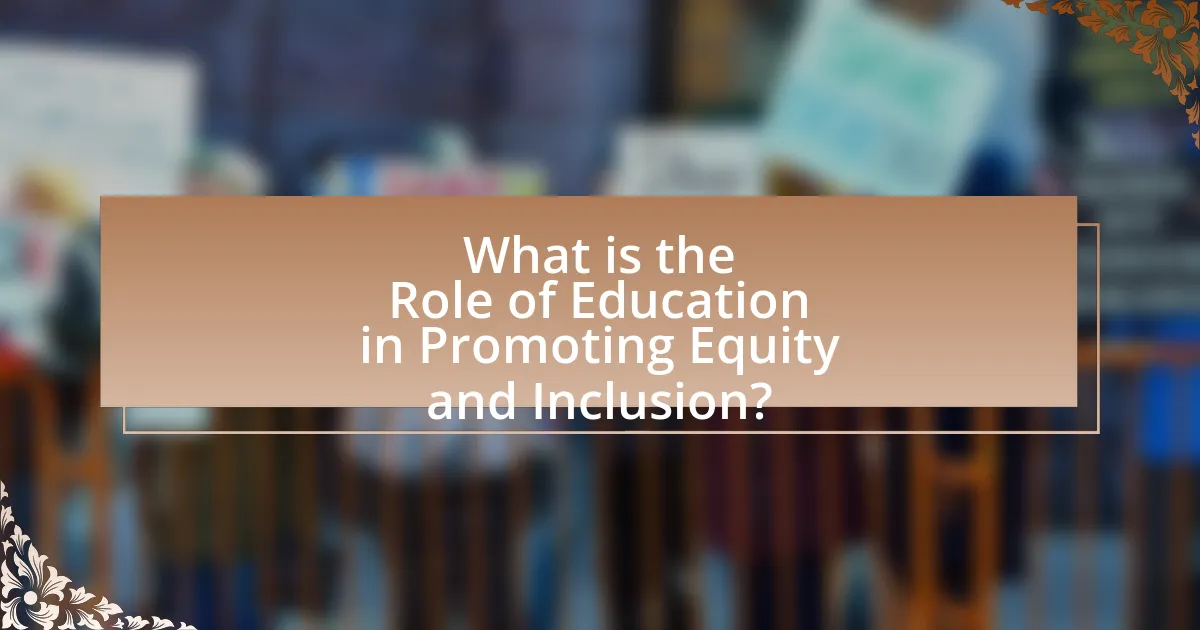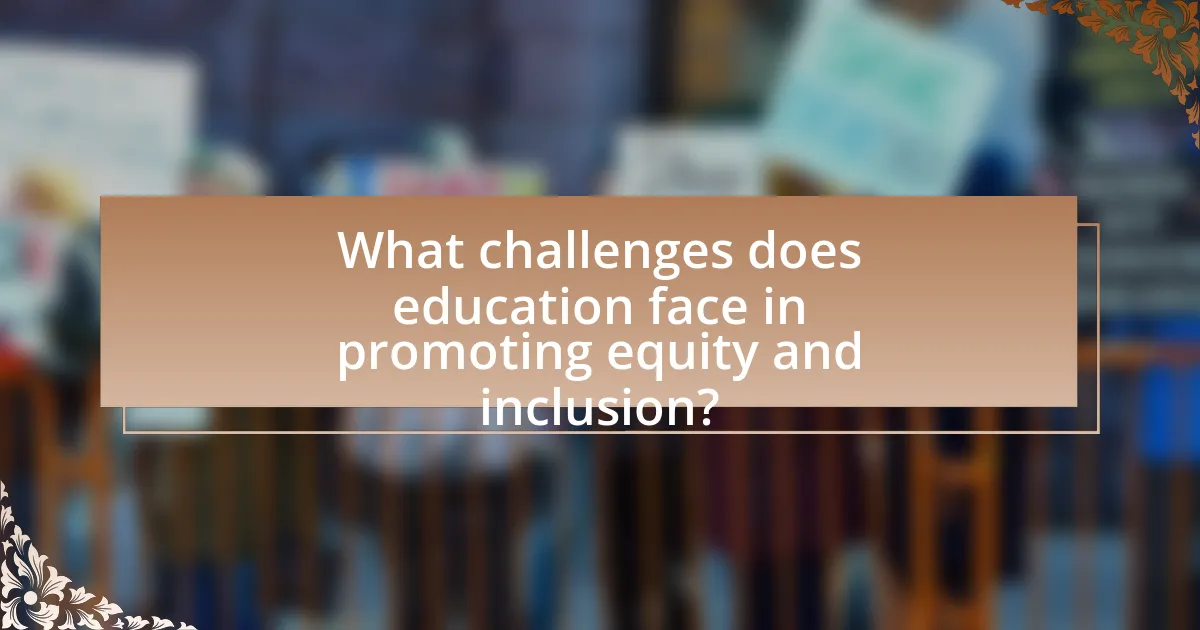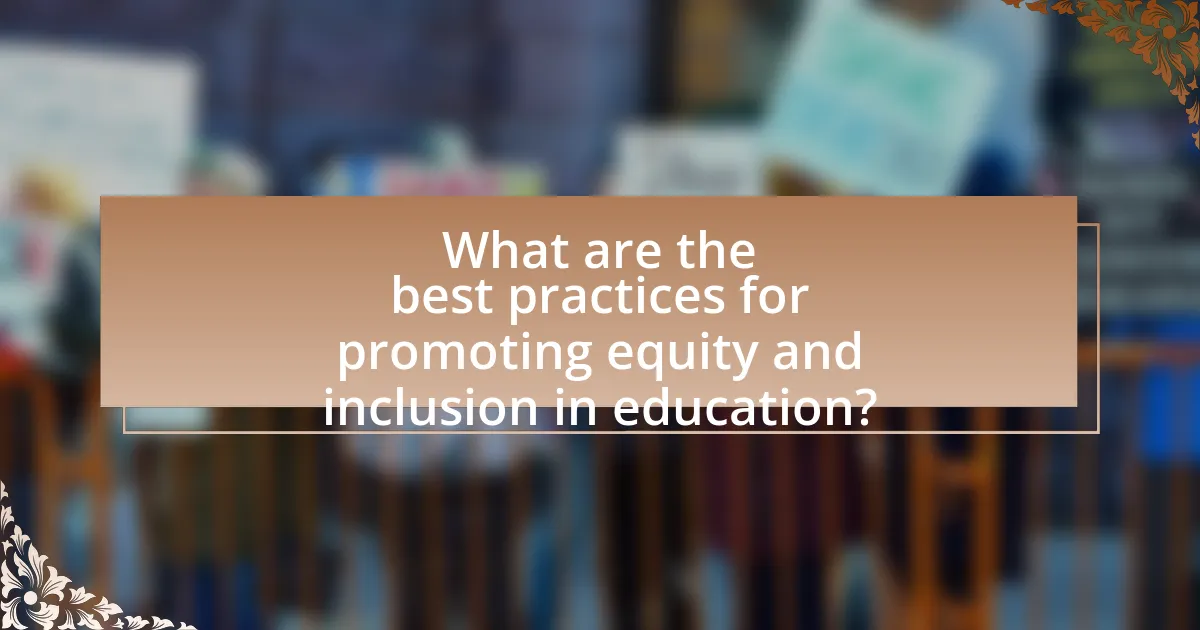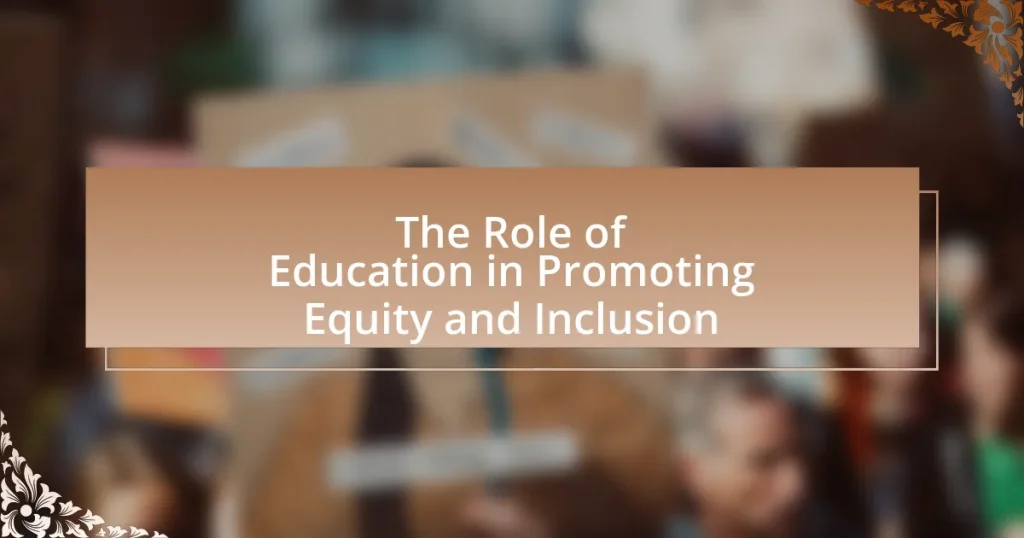Education is a fundamental tool for promoting equity and inclusion, providing individuals from diverse backgrounds with access to quality learning opportunities that facilitate social and economic advancement. The article explores how education contributes to social equity through access, participation, and outcome equity, highlighting the importance of inclusive practices such as differentiated instruction and culturally relevant pedagogy. It addresses the challenges faced in achieving educational equity, including systemic inequalities and resource disparities, while also discussing the role of policy, community involvement, and technology in enhancing educational access and support for marginalized groups. The article emphasizes best practices for fostering an inclusive educational environment and the benefits of engaging families and communities in these efforts.

What is the Role of Education in Promoting Equity and Inclusion?
Education plays a crucial role in promoting equity and inclusion by providing all individuals with access to quality learning opportunities, regardless of their background. This access helps to level the playing field, enabling marginalized groups to gain the skills and knowledge necessary for social and economic advancement. Research indicates that inclusive educational practices, such as differentiated instruction and culturally relevant pedagogy, significantly improve academic outcomes for underrepresented students. For instance, a study by the National Center for Education Statistics found that schools implementing inclusive practices saw a 20% increase in graduation rates among minority students. Thus, education serves as a foundational tool for fostering a more equitable and inclusive society.
How does education contribute to social equity?
Education contributes to social equity by providing individuals with the knowledge and skills necessary to access opportunities and resources. It levels the playing field, enabling marginalized groups to improve their socio-economic status. For instance, research from the Organisation for Economic Co-operation and Development (OECD) indicates that countries with higher educational attainment levels tend to have lower income inequality. Furthermore, education fosters critical thinking and civic engagement, empowering individuals to advocate for their rights and participate in democratic processes, which further promotes social equity.
What are the key principles of equity in education?
The key principles of equity in education include access, participation, and outcome equity. Access equity ensures that all students have the same opportunities to enroll in and attend educational institutions, regardless of their background. Participation equity focuses on providing all students with the necessary support to engage fully in the learning process, which may involve tailored resources for diverse learning needs. Outcome equity emphasizes that all students should achieve similar educational results, reflecting their potential rather than their socio-economic status or other external factors. These principles are supported by research indicating that equitable educational practices lead to improved academic performance and social outcomes for marginalized groups.
How does access to education impact marginalized communities?
Access to education significantly empowers marginalized communities by providing them with essential skills and knowledge necessary for socioeconomic advancement. Education enhances employment opportunities, leading to higher income levels and improved living standards. For instance, according to the World Bank, each additional year of schooling can increase an individual’s earnings by up to 10%. Furthermore, education fosters critical thinking and civic engagement, enabling individuals from marginalized backgrounds to advocate for their rights and participate actively in their communities. This empowerment is crucial for breaking the cycle of poverty and promoting social equity.
Why is inclusion important in educational settings?
Inclusion is important in educational settings because it fosters a sense of belonging and promotes equity among all students. Research indicates that inclusive education enhances academic performance, social skills, and emotional well-being for both students with and without disabilities. A study published in the Journal of Special Education found that inclusive classrooms lead to higher achievement levels for students with disabilities, as they benefit from peer interactions and diverse learning environments. Furthermore, inclusive practices prepare all students for a diverse society, equipping them with the skills necessary for collaboration and understanding in a multicultural world.
What are the benefits of inclusive education for students?
Inclusive education benefits students by fostering a diverse learning environment that enhances social skills, academic performance, and emotional well-being. Research indicates that students in inclusive settings demonstrate improved collaboration and communication skills, as they learn to interact with peers from various backgrounds and abilities. A study published in the Journal of Special Education found that inclusive education can lead to higher academic achievement, with students with disabilities showing significant gains in literacy and math when educated alongside their peers. Furthermore, inclusive education promotes empathy and understanding among all students, preparing them for a diverse society.
How can inclusive practices be implemented in schools?
Inclusive practices can be implemented in schools by adopting differentiated instruction, fostering a supportive environment, and engaging families in the educational process. Differentiated instruction allows teachers to tailor lessons to meet diverse learning needs, ensuring that all students can access the curriculum effectively. Research indicates that when teachers use varied teaching methods, such as visual aids and hands-on activities, student engagement and understanding improve significantly.
Creating a supportive environment involves training staff on cultural competency and anti-bias education, which helps to cultivate an atmosphere of respect and understanding among students from different backgrounds. Studies show that schools with strong anti-bullying policies and inclusive cultures report higher student satisfaction and lower dropout rates.
Engaging families through regular communication and involvement in school activities enhances the sense of community and support for students. According to the National Education Association, schools that actively involve parents in their children’s education see improved academic outcomes and increased student motivation.

What challenges does education face in promoting equity and inclusion?
Education faces significant challenges in promoting equity and inclusion, primarily due to systemic inequalities, resource disparities, and cultural biases. Systemic inequalities manifest in the form of socioeconomic status, race, and geographic location, which affect access to quality education. For instance, students from low-income families often attend underfunded schools, resulting in fewer educational resources and opportunities. Resource disparities further exacerbate this issue, as schools in affluent areas typically have better facilities, experienced teachers, and advanced technology compared to those in disadvantaged communities. Cultural biases also play a role, as curricula may not reflect the diverse backgrounds of all students, leading to feelings of alienation and disengagement among marginalized groups. These factors collectively hinder the ability of educational institutions to create an equitable and inclusive environment for all learners.
What barriers exist to achieving educational equity?
Barriers to achieving educational equity include socioeconomic disparities, systemic racism, and inadequate funding for schools in low-income areas. Socioeconomic disparities create unequal access to resources, such as technology and extracurricular programs, which are essential for a comprehensive education. Systemic racism manifests in discriminatory practices and policies that disproportionately affect marginalized communities, limiting their educational opportunities. Additionally, inadequate funding often results in overcrowded classrooms, outdated materials, and insufficient support services, further hindering the ability of students from disadvantaged backgrounds to succeed academically. According to the National Center for Education Statistics, schools in high-poverty areas receive significantly less funding per student compared to those in affluent areas, illustrating the financial inequities that contribute to the educational gap.
How do socioeconomic factors influence educational access?
Socioeconomic factors significantly influence educational access by determining the resources available to individuals and families for education. Families with higher income levels can afford better educational opportunities, such as private schooling, tutoring, and extracurricular activities, which enhance learning outcomes. In contrast, lower-income families often face barriers such as inadequate school facilities, limited access to technology, and fewer educational support services. According to a report by the National Center for Education Statistics, students from low-income backgrounds are less likely to graduate high school and pursue higher education compared to their wealthier peers, highlighting the direct correlation between socioeconomic status and educational attainment.
What role does policy play in promoting or hindering equity?
Policy plays a crucial role in promoting or hindering equity by establishing frameworks that either support or obstruct access to resources and opportunities. For instance, policies that allocate funding based on need can enhance educational equity by directing resources to underfunded schools, thereby improving student outcomes. Conversely, policies that perpetuate systemic inequalities, such as those that enforce discriminatory practices in school admissions or funding formulas, can hinder equity by maintaining disparities in educational access and quality. Research indicates that equitable funding policies can lead to improved academic performance among marginalized groups, highlighting the significant impact of policy decisions on equity in education.
How can educators address issues of inclusion and equity?
Educators can address issues of inclusion and equity by implementing differentiated instruction and culturally responsive teaching practices. Differentiated instruction allows educators to tailor their teaching methods to meet the diverse needs of students, ensuring that all learners have access to the curriculum. Culturally responsive teaching recognizes and values students’ cultural backgrounds, integrating their experiences into the learning process. Research indicates that schools employing these strategies see improved academic outcomes and increased student engagement, as evidenced by a study published in the “Journal of Educational Psychology,” which found that culturally responsive practices significantly enhance student performance in diverse classrooms.
What strategies can teachers use to foster an inclusive classroom environment?
Teachers can foster an inclusive classroom environment by implementing differentiated instruction, which tailors teaching methods to accommodate diverse learning styles and abilities. This approach allows educators to address the unique needs of each student, ensuring that all learners can engage with the curriculum effectively. Research indicates that differentiated instruction can lead to improved academic outcomes for students with varying abilities, as it promotes active participation and reduces barriers to learning. Additionally, creating a supportive classroom culture through collaborative learning activities encourages peer interaction and respect for diversity, further enhancing inclusivity.
How can schools measure their progress towards equity and inclusion?
Schools can measure their progress towards equity and inclusion by utilizing data-driven assessments, surveys, and performance metrics. These tools allow schools to evaluate student demographics, academic outcomes, and participation rates in various programs. For instance, analyzing standardized test scores and graduation rates across different student groups can reveal disparities that need to be addressed. Additionally, conducting climate surveys can provide insights into students’ and staff’s perceptions of inclusivity and equity within the school environment. Research indicates that schools implementing these measurement strategies can identify gaps and track improvements over time, fostering a more equitable educational landscape.

What are the best practices for promoting equity and inclusion in education?
The best practices for promoting equity and inclusion in education include implementing culturally responsive teaching, ensuring access to resources, and fostering a supportive school climate. Culturally responsive teaching recognizes the diverse backgrounds of students and integrates their cultural references into the curriculum, which has been shown to improve student engagement and achievement. Ensuring access to resources, such as technology and extracurricular activities, helps to level the playing field for all students, particularly those from marginalized communities. Additionally, fostering a supportive school climate that values diversity and encourages open dialogue can significantly enhance students’ sense of belonging and participation. Research indicates that schools with inclusive practices see improved academic outcomes and social-emotional well-being among students, highlighting the effectiveness of these strategies in promoting equity and inclusion.
How can community involvement enhance educational equity?
Community involvement enhances educational equity by fostering collaboration between schools and local stakeholders, which leads to more tailored educational resources and support systems. When community members actively participate in educational initiatives, they can identify specific needs and advocate for equitable access to quality education. For instance, research from the National Education Association indicates that schools with strong community ties often see improved student outcomes, as these partnerships can provide additional funding, mentorship programs, and extracurricular activities that address diverse student needs. This collaborative approach not only enriches the educational environment but also ensures that all students, regardless of their background, have the opportunity to succeed.
What partnerships can schools form to support equity initiatives?
Schools can form partnerships with community organizations, local businesses, and higher education institutions to support equity initiatives. Collaborating with community organizations allows schools to access resources and expertise that address specific needs of marginalized groups, such as tutoring programs or mental health services. Partnering with local businesses can provide internships and job training opportunities, fostering economic equity. Additionally, alliances with higher education institutions can facilitate mentorship programs and college readiness initiatives, helping to bridge the gap for underrepresented students. These partnerships are essential for creating a holistic support system that promotes equity and inclusion within the educational landscape.
How can families be engaged in promoting inclusion?
Families can be engaged in promoting inclusion by actively participating in school activities and advocating for inclusive practices. Research shows that when families collaborate with educators, they help create a supportive environment that values diversity and fosters belonging. For instance, a study published in the “Journal of Educational Psychology” by Fan and Chen (2017) highlights that parental involvement in school initiatives leads to improved student outcomes and a greater sense of community. By attending meetings, volunteering, and communicating with teachers, families can influence policies and practices that promote equity and inclusion in educational settings.
What role does technology play in advancing educational equity?
Technology plays a crucial role in advancing educational equity by providing access to resources and learning opportunities for underserved populations. Digital platforms enable remote learning, allowing students in rural or low-income areas to access quality educational materials and instruction that may not be available locally. For instance, a study by the Pew Research Center found that 87% of teachers believe technology helps students learn more effectively, particularly for those who face barriers in traditional educational settings. Furthermore, adaptive learning technologies personalize education, catering to individual learning styles and paces, which can significantly benefit students with diverse needs.
How can digital tools support inclusive learning environments?
Digital tools can support inclusive learning environments by providing personalized learning experiences that cater to diverse student needs. These tools, such as adaptive learning software and assistive technologies, enable educators to tailor instruction based on individual learning styles and abilities. For instance, research by the National Center on Universal Design for Learning indicates that technology can enhance engagement and accessibility, allowing students with disabilities to participate fully in classroom activities. Furthermore, digital platforms facilitate collaboration among students, fostering a sense of community and belonging, which is essential for an inclusive educational atmosphere.
What are the potential pitfalls of technology in education equity?
The potential pitfalls of technology in education equity include exacerbating existing inequalities, creating a digital divide, and fostering dependency on technology. Research indicates that students from low-income backgrounds often lack access to necessary devices and reliable internet, which hinders their ability to engage with digital learning platforms effectively. For instance, a report by the Pew Research Center found that 35% of lower-income households with school-age children do not have a high-speed internet connection, limiting their educational opportunities. Additionally, over-reliance on technology can lead to diminished critical thinking and problem-solving skills, as students may become accustomed to seeking quick answers online rather than engaging deeply with the material. These factors collectively highlight the risks of technology reinforcing rather than reducing educational disparities.
What practical steps can educators take to promote equity and inclusion?
Educators can promote equity and inclusion by implementing culturally responsive teaching practices. This approach involves recognizing and valuing students’ diverse backgrounds, which enhances engagement and learning outcomes. Research indicates that culturally responsive teaching can improve academic performance for marginalized groups, as it fosters a sense of belonging and respect in the classroom. Additionally, educators should provide differentiated instruction tailored to individual learning needs, ensuring that all students have access to the curriculum. Studies show that differentiated instruction leads to higher achievement levels among diverse learners. Furthermore, creating a safe and inclusive classroom environment, where all voices are heard and respected, is essential. According to the National Education Association, inclusive classrooms contribute to better social-emotional development and academic success for all students.










